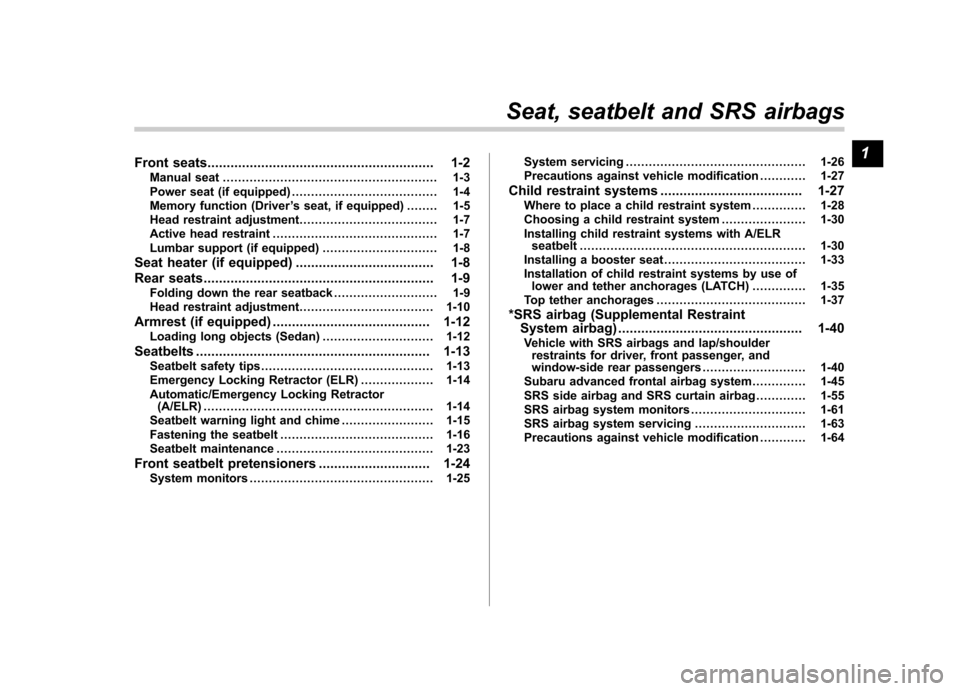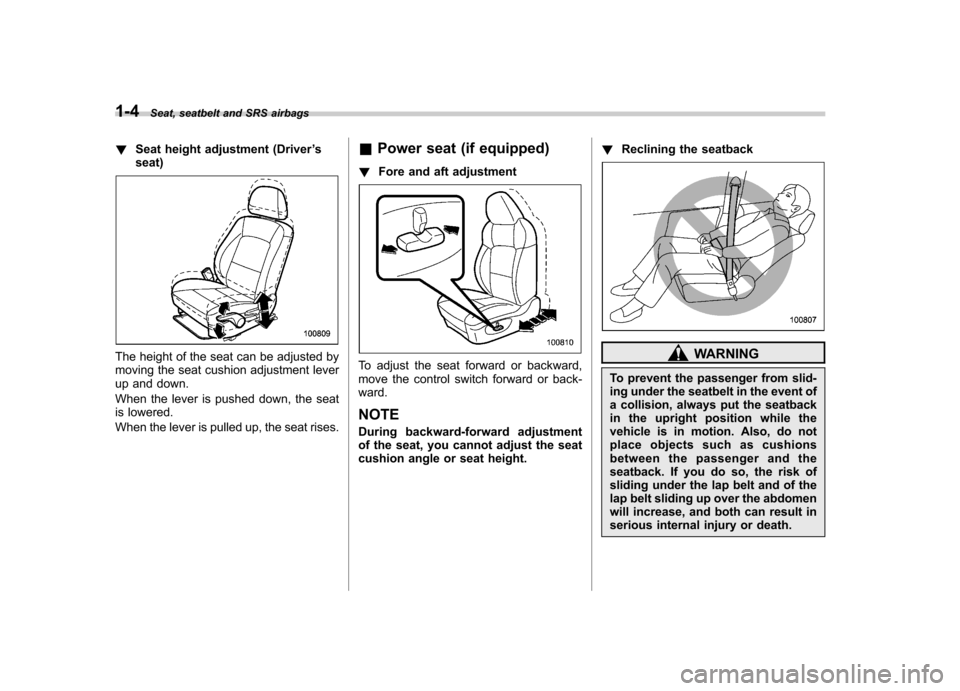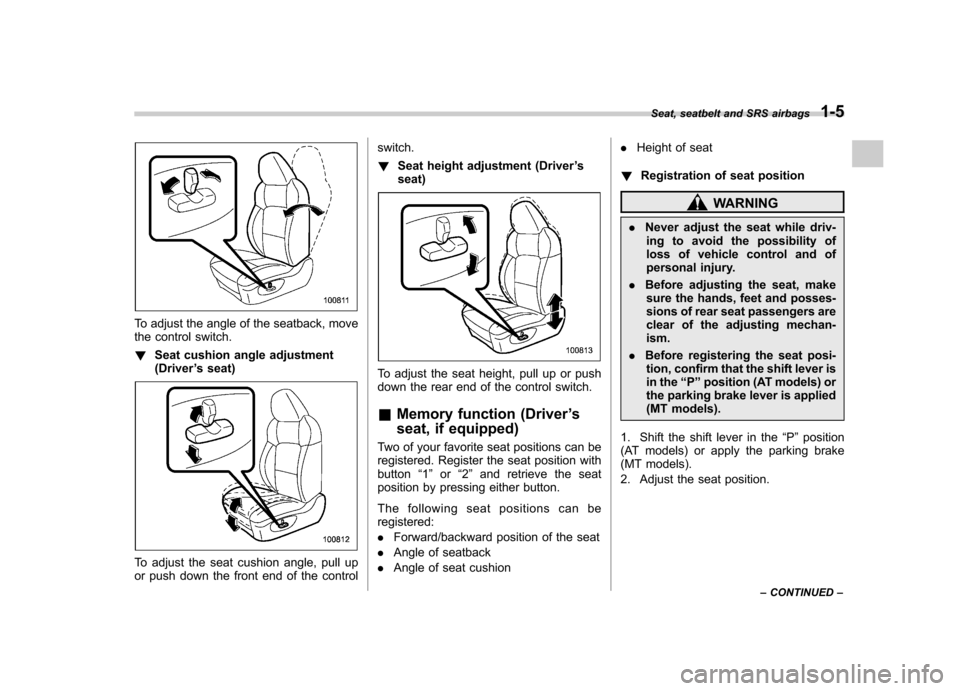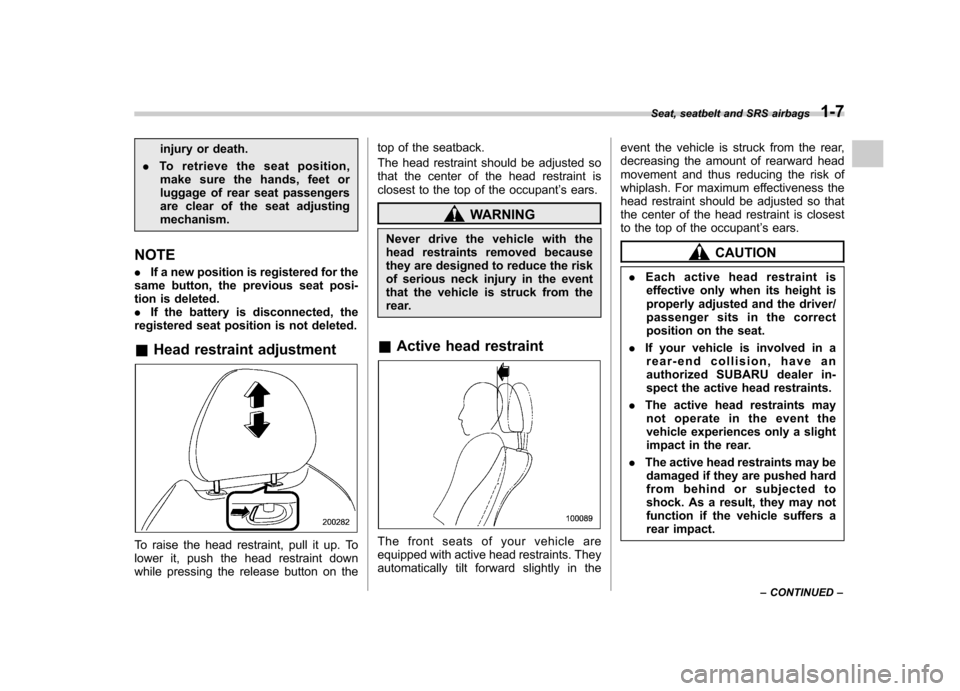driver seat adjustment SUBARU OUTBACK 2008 4.G Owners Manual
[x] Cancel search | Manufacturer: SUBARU, Model Year: 2008, Model line: OUTBACK, Model: SUBARU OUTBACK 2008 4.GPages: 444, PDF Size: 14.1 MB
Page 26 of 444

Front seats........................................................... 1-2
Manual seat ........................................................ 1-3
Power seat (if equipped) ...................................... 1-4
Memory function (Driver ’s seat, if equipped) ........ 1-5
Head restraint adjustment .................................... 1-7
Active head restraint ........................................... 1-7
Lumbar support (if equipped) .............................. 1-8
Seat heater (if equipped) .................................... 1-8
Rear seats ............................................................ 1-9
Folding down the rear seatback ........................... 1-9
Head restraint adjustment ................................... 1-10
Armrest (if equipped) ......................................... 1-12
Loading long objects (Sedan) ............................. 1-12
Seatbelts ............................................................. 1-13
Seatbelt safety tips ............................................. 1-13
Emergency Locking Retractor (ELR) ................... 1-14
Automatic/Emergency Locking Retractor (A/ELR) ............................................................ 1-14
Seatbelt warning light and chime ........................ 1-15
Fastening the seatbelt ........................................ 1-16
Seatbelt maintenance ......................................... 1-23
Front seatbelt pretensioners ............................. 1-24
System monitors ................................................ 1-25 System servicing
............................................... 1-26
Precautions against vehicle modification ............ 1-27
Child restraint systems ..................................... 1-27
Where to place a child restraint system .............. 1-28
Choosing a child restraint system ...................... 1-30
Installing child restraint systems with A/ELR seatbelt ........................................................... 1-30
Installing a booster seat ..................................... 1-33
Installation of child restraint systems by use of lower and tether anchorages (LATCH) .............. 1-35
Top tether anchorages ....................................... 1-37
*SRS airbag (Supplemental Restraint System airbag) ................................................ 1-40
Vehicle with SRS airbags and lap/shoulder restraints for driver, front passenger, and
window-side rear passengers . .......................... 1-40
Subaru advanced frontal airbag system .............. 1-45
SRS side airbag and SRS curtain airbag ............. 1-55
SRS airbag system monitors .............................. 1-61
SRS airbag system servicing ... .......................... 1-63
Precautions against vehicle modification ............ 1-64
Seat, seatbelt and SRS airbags1
Page 29 of 444

1-4Seat, seatbelt and SRS airbags
!Seat height adjustment (Driver ’s
seat)
The height of the seat can be adjusted by
moving the seat cushion adjustment lever
up and down.
When the lever is pushed down, the seat
is lowered.
When the lever is pulled up, the seat rises. &
Power seat (if equipped)
! Fore and aft adjustmentTo adjust the seat forward or backward,
move the control switch forward or back-ward. NOTE
During backward-forward adjustment
of the seat, you cannot adjust the seat
cushion angle or seat height. !
Reclining the seatbackWARNING
To prevent the passenger from slid-
ing under the seatbelt in the event of
a collision, always put the seatback
in the upright position while the
vehicle is in motion. Also, do not
place objects such as cushions
between the passenger and the
seatback. If you do so, the risk of
sliding under the lap belt and of the
lap belt sliding up over the abdomen
will increase, and both can result in
serious internal injury or death.
Page 30 of 444

To adjust the angle of the seatback, move
the control switch. !Seat cushion angle adjustment (Driver ’s seat)
To adjust the seat cushion angle, pull up
or push down the front end of the control switch. !
Seat height adjustment (Driver ’s
seat)
To adjust the seat height, pull up or push
down the rear end of the control switch. & Memory function (Driver ’s
seat, if equipped)
Two of your favorite seat positions can be
registered. Register the seat position withbutton “1 ” or “2 ” and retrieve the seat
position by pressing either button.
The following seat positions can be registered: . Forward/backward position of the seat
. Angle of seatback
. Angle of seat cushion .
Height of seat
! Registration of seat position
WARNING
. Never adjust the seat while driv-
ing to avoid the possibility of
loss of vehicle control and of
personal injury.
. Before adjusting the seat, make
sure the hands, feet and posses-
sions of rear seat passengers are
clear of the adjusting mechan-ism.
. Before registering the seat posi-
tion, confirm that the shift lever is
in the “P ” position (AT models) or
the parking brake lever is applied
(MT models).
1. Shift the shift lever in the “P ” position
(AT models) or apply the parking brake
(MT models).
2. Adjust the seat position. Seat, seatbelt and SRS airbags
1-5
– CONTINUED –
Page 32 of 444

injury or death.
. To retrieve the seat position,
make sure the hands, feet or
luggage of rear seat passengers
are clear of the seat adjustingmechanism.
NOTE . If a new position is registered for the
same button, the previous seat posi-
tion is deleted.. If the battery is disconnected, the
registered seat position is not deleted. & Head restraint adjustment
To raise the head restraint, pull it up. To
lower it, push the head restraint down
while pressing the release button on the top of the seatback.
The head restraint should be adjusted so
that the center of the head restraint is
closest to the top of the occupant
’s ears.
WARNING
Never drive the vehicle with the
head restraints removed because
they are designed to reduce the risk
of serious neck injury in the event
that the vehicle is struck from the
rear.
& Active head restraint
The front seats of your vehicle are
equipped with active head restraints. They
automatically tilt forward slightly in the event the vehicle is struck from the rear,
decreasing the amount of rearward head
movement and thus reducing the risk of
whiplash. For maximum effectiveness the
head restraint should be adjusted so that
the center of the head restraint is closest
to the top of the occupant
’s ears.
CAUTION
. Each active head restraint is
effective only when its height is
properly adjusted and the driver/
passenger sits in the correct
position on the seat.
. If your vehicle is involved in a
rear-end collision, have an
authorized SUBARU dealer in-
spect the active head restraints.
. The active head restraints may
not operate in the event the
vehicle experiences only a slight
impact in the rear.
. The active head restraints may be
damaged if they are pushed hard
from behind or subjected to
shock. As a result, they may not
function if the vehicle suffers a
rear impact. Seat, seatbelt and SRS airbags
1-7
– CONTINUED –